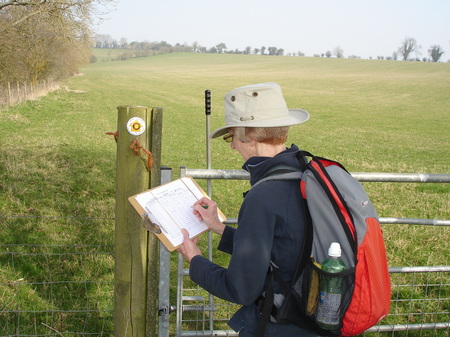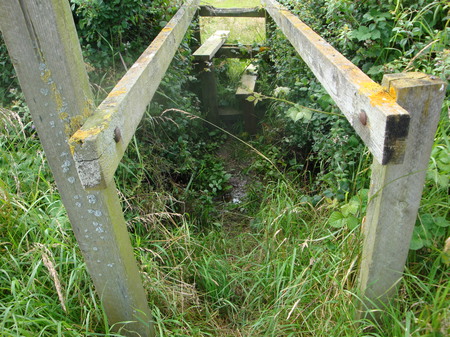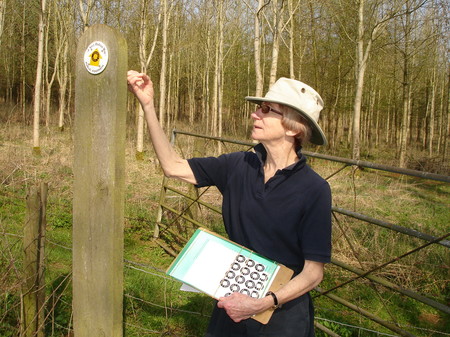- From the Chairman
- Health and Safety – an OFS insurance issue
- What do you remember?
- D'Arcy Dalton Way circular walks survey 2012
- Residential visit to Cardigan
- Residential visit to Abingworth
- The Southern section of the Oxfordshire Way
- Footpath diversions, etc.
- The Devil's Quoits
- Volunteer work parties
- Committee News
D'Arcy Dalton Way circular walks survey 2012
Last year OFS volunteers undertook a systematic survey of the 66 mile long d'Arcy Dalton Way. The Way commemorates one of the most notable defender of Oxfordshire's rights of way, Colonel W. P. d'Arcy Dalton (1893-1981). D'Arcy, as he was known to his friends, was a founder member of the OFS in 1926 and its first assistant secretary. For over 50 years he served the Society, first as honorary secretary, then as an Executive Committee member and Chairman and finally as President. His name is now to be found on the specially-made signs on the finger posts that direct the walker along the Way.
It was created in 1986 to mark the OFS's Diamond Jubilee in 1986 and devised by Nick Moon with the aim of linking together a number of footpaths running generally north-south across the County in order to provide a continuous long-distance trail.
Volunteers surveyed the Way in 12 stages and recorded on survey sheets, stiles, footbridges, way marks and finger posts which were considered, as a result of the survey, to be in need of repair or replacement. This information, consisting of survey reports and a detailed map on each stage, was given to Dan Weeks, the Field Officer for West Oxfordshire in the County Council's Countryside Department.
 Photo: Jim Parke
Photo: Jim Parke
This year the Volunteers are surveying 10 Circular Walks which incorporate sections of the d'Arcy Dalton Way. They stretch from the village of Claydon in the north of the county to White Horse Hill in the south. The Walks are described in detail in two books published by Nick Moon: 'The d'Arcy Dalton Way across the Oxfordshire Cotswolds and Thames Valley', (1999) and 'Oxfordshire Walks, Oxford, The Cotswolds and the Cherwell Valley' (1998). Both books are published by The Book Castle.
 Photo: Liz Adams
Photo: Liz Adams
Building on the experience of the first survey and following a suggestion of Dan Weeks, it was decided to develop proformas on which to record more detailed information for each defective stile, bridge or gate. I thank Peter Ewart and John Eyre for their assistance with the format of the proformas. This, together with photographs, will provide the Countryside Service with specific information on the necessary repairs to the path infrastructure to bring it up to standard.
Another innovation has been self-adhesive decals with a 'circular route' logo to put on way marks and finger posts in order to define the circular walk.
I am most grateful to those OFS volunteers who, armed with proformas and detailed track-log plans of their circular walk, undertook the survey. It required a careful assessment, and often measurement, particularly of the stiles to see if they conform to standard. The very wet weather of the early summer did not help. (It is impossible to record information on paper which gradually deteriorates to a soggy mess if it rains!)
However steady progress was made; the first set of surveys of five completed walks was handed to the Countryside Service in mid-June and the remaining five walks completed by mid-August.
In general it was found that the path infrastructure was in good shape. However a number of stiles, and in a very few cases bridges, will require some degree of repair work to make them more accessible. The most common problem with stiles is that the lowest footplate is too high (ideally no higher than 350mm) or too narrow, or indeed altogether missing. A few way mark posts were found to have rotted off at the base and were either lying on the ground or propped against a nearby hedge. The quality of gates, both wooden and metal, varied greatly. The most common feature of a poor quality gate resulted from a misalignment, through movement, of the supporting posts with the effect that it did not close properly.
 Photo: Jim Parke
Photo: Jim Parke
One encouraging development of the survey work undertaken by the Society is that there is evidence that the County Council's Countryside Service is attending to the problems identified in our first survey. As the circular walks incorporate sections of the d'Arcy Dalton Way we have been able to check that poor stiles have been repaired or, better still, replaced by kissing gate as has happened in a number of cases. The Countryside Service is very appreciative of the Society's survey work. It is hoped that co-operation between the Society and the Countryside Service will continue and prosper in the future.
